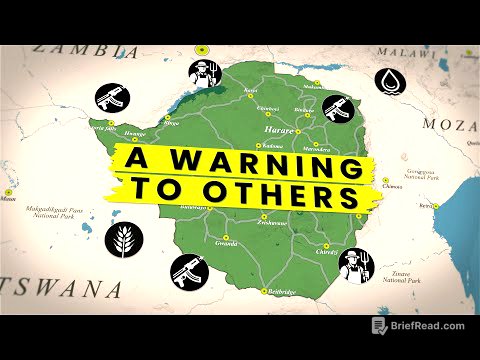TLDR;
This video explores the complex and controversial relationship between the United States and Iran, from the early 20th century to 2020. It covers key events such as the discovery of oil in Iran, the Anglo-Iranian Oil Company's unfair terms, the overthrow of Prime Minister Muhammad Mozedc, the Iranian Revolution, the hostage crisis, the Iran-Iraq War, and the 2015 nuclear deal. The video also discusses the escalating tensions under the Trump administration, culminating in the assassination of General Kasamsmani and the retaliatory missile strikes. It concludes with the accidental downing of Ukraine International Airlines Flight 752 and a reflection on the precarious nature of peace between the two nations.
- Oil discovery and British exploitation set the stage for future conflict.
- The 1953 coup and support for the Shah created resentment and distrust.
- The Iranian Revolution transformed Iran into an anti-Western theocracy.
- The hostage crisis and Iran-Iraq War deepened the divide between the US and Iran.
- The 2015 nuclear deal offered a brief period of reproachment, but tensions soon escalated again.
Early Oil Discoveries and British Influence [1:14]
At the beginning of the 20th century, the British discovered oil in Iran, revealing that the country held the fourth-largest proven reserves of oil on the planet. Britain negotiated a deal with Iran to create the Anglo-Iranian Oil Company, but the terms were heavily skewed in Britain's favor, with Iran only receiving 16% of the profits while Britain took 84%. By the start of World War II, the Anglo-Iranian Oil Company controlled all of Iran's oil and became the largest company in the British Empire, leading to growing discontent within Iran due to the unfair terms.
World War II and Allied Occupation [2:27]
During World War II, Iran's geographical location on the Soviet Union's southern flank raised suspicions among the British and Soviets, who considered the Shah to be too friendly with the Nazis. To prevent Iran from potentially cooperating with the Axis and to secure a transportation corridor for supplies to the Soviet Union, the Soviets and British invaded neutral Iran in 1941. The Shah was overthrown and replaced with his younger son, Muhammad Raza Palavi, who was deemed more amenable to Allied interests. Iran was occupied by the Allies for the duration of the war, during which the country served as a crucial supply route to the Soviet Union.
The Overthrow of Prime Minister Mozedc [4:11]
After World War II, the unfair terms of the Anglo-Iranian Oil Company were once again questioned. By the early 1950s, Britain continued to take the majority of Iran's oil profits, while Iranian oil workers faced terrible conditions. In 1951, Iran's democratically elected Prime Minister Muhammad Mozedc nationalized the company with unanimous approval from the Iranian Parliament. Britain responded by embargoing Iranian oil, and in 1953, Britain's MI6 and America's CIA organized a military coup to overthrow Mozedc's government, resulting in the deaths of approximately 300 Iranians. Mozedc was placed under house arrest for the rest of his life, and the Shah was reinstated as an authoritarian dictator with the backing of Western powers.
The Shah's Rule and Growing Discontent [5:20]
The Shah's rule, supported by the West, led to Iran becoming a valuable ally of the United States during the Cold War due to its strategic location and vast oil reserves. The Shah pursued pro-American and pro-Israel policies, but his cozy relations with the West alienated much of his home-based support. He established a secret police force that arrested thousands of political opponents, exiled figures like Ayatah, and reportedly engaged in widespread torture of political dissidents. His policies of modernization, secularism, and the enfranchisement of women alienated leftists, the working class, and conservative Shiite Muslims.
The Iranian Revolution [6:42]
By the late 1970s, political unrest in Iran escalated into a full-scale revolution. A movie theater fire in Abadan killed at least 420 people, with protesters blaming the Shah's secret police. Protesters gathered in Tehran's main square, and the Shah's army opened fire, killing and wounding hundreds. Millions of Iranians took to the streets, demanding the Shah's abdication. In early 1979, Muhammad Palavi fled the country, and a radical Shiite Islamist government replaced his regime. Ayatollah Kam was invited back to the country after 15 years of exile to become Iran's new supreme leader, marking the birth of the modern Islamic Republic of Iran.
The Hostage Crisis and Severed Relations [7:45]
The new Iranian regime was a totalitarian Shiite theocracy staunchly opposed to the United States and Israel, leading to mass executions and purges of political opponents. The Islamic revolution came as a shock to the United States, transforming Iran from a key ally to a major enemy. When the United States welcomed the overthrown Shah for cancer treatment, Iran demanded his extradition to stand trial for his crimes. In November 1979, Iranian revolutionaries stormed the American embassy and took 52 American diplomats and civilians hostage. A rescue operation authorized by President Carter in 1980 failed, resulting in the deaths of eight American soldiers. The United States then severed all diplomatic relations with Iran, which have remained frozen ever since.
The Iran-Iraq War and US Support for Saddam [9:54]
In September 1980, Saddam Hussein's Iraq launched an invasion of Iran, aiming to supplant Iran as the dominant power in the Persian Gulf. Taking advantage of the chaos following the Iranian Revolution, Saddam expected a swift victory, but the war turned into an eight-year stalemate. Iran agreed to release the 52 American hostages after 444 days. The United States levied heavy economic sanctions on Iran and began heavily supplying Saddam and Iraq in their war effort, hoping to destabilize Iran further. The Iran-Iraq War became one of the bloodiest conflicts of the 20th century, with approximately 400,000 Iranians losing their lives, partly due to Iraq's use of chemical weapons and landmines, supported by the United States.
Escalating Tensions and Military Engagements [11:42]
Throughout the Iran-Iraq War, the US contended that Hezbollah, a Shia Islamist militia organization operating out of Lebanon and backed by Iran, carried out multiple anti-American terror attacks. These included the 1983 bombing of the US embassy in Beirut and a truck bombing against a military compound in Lebanon, resulting in numerous American and French casualties. In 1984, the United States placed Iran on its state sponsors of terrorism list. In April 1988, during the ongoing Iran-Iraq War, an American frigate struck an Iranian mine in the Persian Gulf. The US retaliated with Operation Praying Mantis, the largest US naval combat operation since World War II, destroying Iranian oil platforms and sinking six warships, resulting in significant Iranian casualties.
The Downing of Iran Air Flight 655 [13:11]
In July 1988, an American cruiser strayed into Iranian territorial waters and, misidentifying Iran Air Flight 655 as an Iranian fighter jet, launched a missile that destroyed the plane. All 290 people on board, including 24 Iranians, were killed in what became the deadliest aviation shootdown incident in history until the Malaysia Airlines Flight 17 disaster in Ukraine. These events sharply escalated tensions between the United States and Iran.
Further Sanctions and Terrorist Attacks [14:09]
In 1995, the Clinton administration enacted a total embargo on all dealings with Iran by any American-based company, effectively halting all trade between the two countries. In 1996, Hezbollah carried out another terror bombing strike against a US target in Saudi Arabia, killing 19 American Air Force personnel and wounding nearly 500 others.
The Axis of Evil and Nuclear Ambitions [14:44]
Following the September 11th attacks, President Bush labeled Iran, Iraq, and North Korea as an "axis of evil" in 2002. The United States then invaded Iraq in 2003 under the pretext of Saddam possessing weapons of mass destruction, though no such weapons were ever found. This sent a clear message to Iran and North Korea: develop nuclear weapons or face potential invasion. North Korea successfully tested an atomic bomb in 2006, while Iran also pursued nuclear weapons research.
The Iran Nuclear Deal and Subsequent Withdrawal [15:35]
By 2015, the Obama administration negotiated the Joint Comprehensive Plan of Action (JCPOA), also known as the Iran nuclear deal. Under the agreement, the US agreed to end a series of sanctions on Iran, while Iran agreed to give up its pursuit of nuclear research and allow foreign inspections. However, in 2016, Donald Trump was elected President of the United States and vowed to withdraw the US from the Iran nuclear deal and reinstate tougher economic sanctions. In 2018, Trump followed through with these promises, leading Iran to threaten to continue its nuclear program and potentially close the Strait of Hormuz to international shipping.
Escalating Tensions and Military Confrontations (2019) [16:44]
In May and June of 2019, several merchant ships traveling through the Persian Gulf were damaged in violent incidents, with the West blaming Iran, who denied involvement. In June, Iran shot down an American drone flying over the Strait of Hormuz. In July, a British oil tanker was seized by the UK for shipping oil to Syria in violation of EU sanctions, and Iran retaliated by capturing a British oil tanker in the Persian Gulf.
The Assassination of General Solmani and Retaliatory Strikes (2020) [17:31]
Tensions escalated further at the end of 2019. In December, a rocket artillery attack on America's K1 military base in Iraq killed a US contractor, leading the US to retaliate with airstrikes against Hezbollah's weapons depots in Iraq and Syria. In late December, Iran-backed militia men attacked the United States embassy in Baghdad. On January 3, 2020, tensions reached unprecedented levels when a US drone strike, authorized by President Trump, assassinated Iranian Major General Kasamsmani in Baghdad.
Retaliation and the Downing of Ukraine International Airlines Flight 752 [19:38]
In response to Solmani's death, Iran launched ballistic missile strikes against US military bases in Iraq on January 8, 2020. While the attacks caused significant damage, there were no casualties, allowing both sides to de-escalate. However, tragedy struck when an Iranian missile battery, on high alert, mistakenly shot down Ukraine International Airlines Flight 752 shortly after takeoff from Tran, killing all 176 people on board, including 82 Iranian and 63 Canadian citizens. The Iranian government initially denied responsibility but later admitted to the accidental downing, sparking massive protests against the regime.









